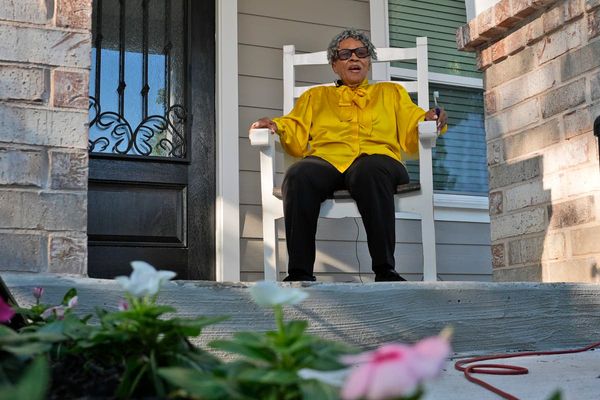
The mature baobab tree could have been anything upwards of 200 years old. Peter Wambua* did not know the age of the baobab that grew on his land, but he felt lucky when he was approached by a man who wanted to buy it. Wambua is not wealthy and once the tree was removed from his farm in Kilifi, on the coast of Kenya, he was able to put the cash to good use, for seeds, fertiliser and food for his family.
Wambua, who spoke to the Guardian on condition of anonymity, found out that the buyer was an agent for a group of contractors taking the giant trees to transplant them to Georgia. Farmers in Kilifi have sold at least eight of their age-old baobabs to the group. However, reports of the trees, which can live for up to 2,500 years, being uprooted for export have alarmed environmental groups, which have called it “biopiracy”.
“Everybody was willing to sell,” says Johna Kahindi, a real estate broker from the area. “Many people in our community are very poor, so even 100,000 [Kenyan shillings] would be seen as a lot of money.”
People in Kilifi say a group of foreign and local contractors, led by a Georgian national, Georgy Gvasaliya, began prospecting for baobabs in late 2019, using drones to search the area for the “perfect” trees. They say they were searching for baobabs meeting their specifications – which included untarnished trunks – with offers ranging from 100,000 to 300,000 Kenyan shillings (£730-£2,200).
Gvasaliya says he began prospecting after hearing that residents were cutting down baobabs to make way for farming. “They were killing [the trees] even without me because they want to plant maize,” he says. “I don’t see anything wrong if we save the tree, which they can’t use for firewood or charcoal. I don’t see any tragedy here. [The] tragedy is killing trees for nothing.”
Trees are sold for transplanting to many countries, he says, pointing to Australian and South African websites where baobabs can be found for sale. He plans to take the Kilifi baobabs to botanical gardens in Georgia.

Baobabs provide a habitat for numerous species of insects, reptiles and birds, and there are real fears the trees’ removal will have a serious ecological impact.
The trees can also withstand harsh climatic conditions, which environmentalists say makes it even more important for Kenya to conserve them as it grapples with drought and tries to regain lost forest cover. The Kilifi region had the third-highest rate of tree-cover loss in Kenya over the last two decades, at a rate of more than three times the national average, according to Global Forest Watch.
Gus Le Breton, chair of the African Baobab Alliance, says: “It’s biopiracy. I cannot see any justification for taking a reproductive tree from some part of the world and moving it to another.”
Last month, Kenya’s National Environmental Management Authority (NEMA) and the Forest Service filed a complaint against the contractors with the director of public prosecutions, saying the contractors did not have the required licences, including an environmental impact assessment, or a permit to transfer the trees. Since then, the impact assessment has been submitted, but the authority has not withdrawn the case.
George Oyoo, NEMA’s Kilifi county director, says the contractors were “uncooperative” because they had obtained a licence from the Kenya Plant Health Inspectorate Service, the body responsible for issuing export permits. The Guardian has seen a copy of a permit issued to Gvasaliya in April for the export to Georgia of 500 tonnes of baobab.
Environmentalists have accused the authorities of being slow to act, and are sceptical that they did not know about it earlier, because of the scale of interest the contractors’ prospecting attracted in the area.
The environment agency maintains there is little they can do to halt the sales because the baobabs were on privately owned land. “The issue here is about ownership rights. This is a tree belonging to an individual. It’s not protected; it’s not on government land,” says Oyoo.
Policy experts disagree, saying the government has the discretion to approve or reject felling requests. The Nagoya Protocol, an international agreement that governs the conditions for the export of genetic resources and has been incorporated into Kenyan law, requires communities to give prior informed consent on the use of resources, and an agreement between whoever is taking them, the government and the community, on how the benefits should be shared.

“If there are no agreements related to Nagoya, it does not matter whether [the land was privately owned] or not – that is an illegality,” says Kavaka Watai Mukonyi, former head of bioprospecting at the Kenya Wildlife Service, who negotiates resource agreements.
“The appropriate stakeholders should have been identified; they sit together and negotiate,” he says, adding that the failure to involve economists in agreements such as these leave the country, and its people, shortchanged.
The economic benefit of baobabs are not apparent to many people in Kilifi. It can take two decades for the tree to produce its first fruit, so farmers such as Wambua see the benefit in selling them to create space for maize and other crops.
The trees have international appeal, however. When baobabs were approved for export to Europe in 2008, their fruit was hailed as a “superfood” because of its high levels of vitamin C, antioxidants, calcium, potassium and fibre. Powder found in the fruit is commonly used in smoothies and porridge. Its bark has medicinal properties and oil in the seeds is used in beauty products.
“All parts of baobab are useful,” says Anthony Maina, director of Wild Living Resources. “It’s zero to waste.” His organisation trains farmers to conserve baobabs and make a livelihood from them. Maina believes farmers can make more money in the long run by selling baobab products instead of the trees.
Wambua accepted 100,000 Kenyan shillings for his tree but now says he feels exploited. He says that he and the contractors’ agent agreed on a price before he knew who the “real buyer” was or what it was going to be used for.
He claims he had to “insist” on a written sale agreement, and was paid in sporadic instalments. He also claims that many of the pre-sale promises were not met, including commitments to develop his home and repair any damage caused by uprooting and transporting the tree.
Gvasaliya strongly denies these claims. “I don’t know what owners you met. It is the wrong information. You’re talking to neighbours, jealous neighbours.”
He adds that he paid farmers more than they had asked for and that he built a school in Kilifi that is attended by 300 children.
Kahindi says a number of the farmers sold their baobabs without realising they were for export.

The trees are now being stored in metal cages in Kilifi, guarded by security officers. Images seen by the Guardian show the trees being removed using heavy machinery. The contractors have levelled the roads where the baobabs will be transported, and have built a jetty for them to be transferred to a ship.
“Uprooting baobabs is not a small undertaking,” says Maina. The trees have huge trunks that can reach heights of more than 20 metres (65ft), and their roots can run as deep as 2 metres.
“They invested a lot in getting and transporting those trees,” says Kahindi.
Unverified reports suggest that millions of dollars are being spent on the baobab transfers.
The environment agency, meanwhile, says new policies on managing heritage trees, such as baobabs, may be needed.
* Name changed to protect identity
Sign up for a different view with our Global Dispatch newsletter – a roundup of our top stories from around the world, recommended reads, and thoughts from our team on key development and human rights issues, delivered to your inbox every two weeks:







